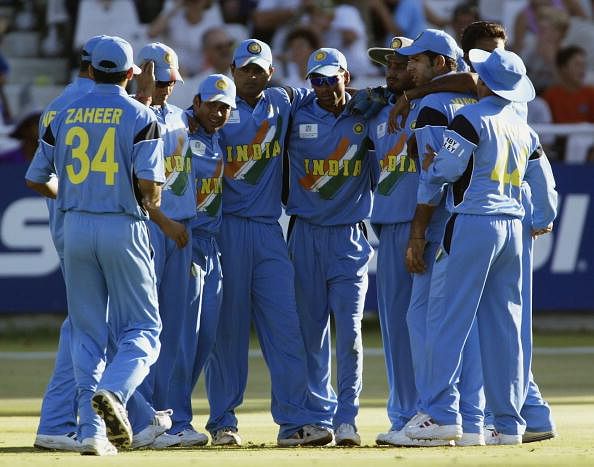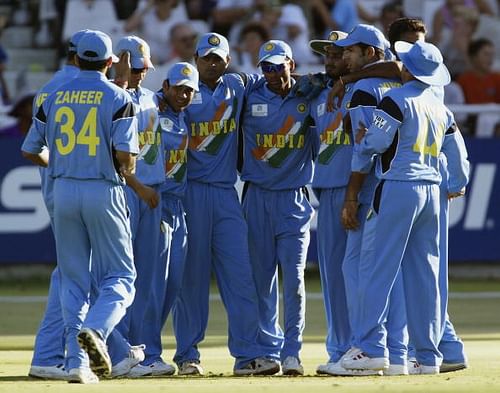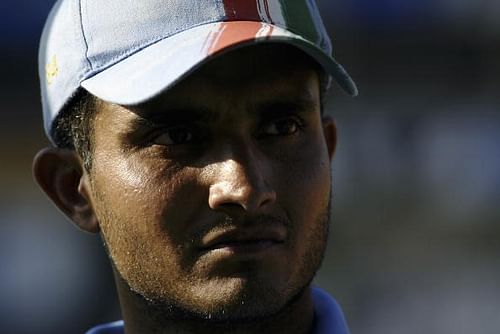
2003 World Cup - When Ganguly led Team India's turnaround

Team India’s huddle
India lifted the Champions Trophy recently, and there has been a lot of optimism about how the team has been performing under the leadership of MS Dhoni.
The words of praise usually involve terms like ‘self-belief’, ‘aggression’, ‘domination’, ‘young blood’ and so on. India’s agility on the field is praised to the skies.
All this is absolutely true. However, these are not attributes that just popped up with the captainship of MS Dhoni. A lot of what we see today is the fruit of that seed that was sown long back in Indian cricket.
The gradual rise of India in international cricket has been a process of evolution in which a lot that was profitable was carried forward, and that which was a deterrent was rejected through disuse. In this process of evolution, the period under Sourav Ganguly stands out as a reign of radical change.
India’s performance at the World Cup of 2003 prophesied a change in attitude. Ganguly’s aggression and John Wright’s composure made for a complementary partnership. It changed the way India approached their cricket completely as they seemed like a team which was out on a conquest to win everything.
In the past, they had been a set of individuals who did their best, but exhibited a soft crumbling bulk underneath under the hard surface. India had failed at the super six stage in 1999, and they wanted to go a step ahead in 2003.
The huddle is still recalled as a new invention in Indian cricket that became a symbol of unity. It was a ‘war cry’, as Ganguly called it; the embodiment of the realization that India’s best chance lay in performing as a team. The huddle continues to be a part of Indian cricket.
The Indian team had faced a lot of flak ahead of their eight-match run to the finals of 2003 World Cup in South Africa. They had just lost a series at home to the West Indies and were routed by New Zealand. Moreover, the first two games of the World Cup were anything but satisfactory.
They scraped a victory against minnows Holland, and then slipped to a humiliating defeat against Australia that even prompted a discussion in the Indian parliament. The then Prime Minister Atal Bihar Vajpayee had to make an appeal to the Indian fans to keep calm and cheer their team. Things looked bleak indeed. It was then that the turnaround happened.

Ganguly was focused on what he wanted. He wanted the guidance of experience but he also wanted swift-footed youngsters who were ambitious and had the appetite for success. He built that young team around a core group of player who provided the foundation.
Rahul Dravid and Sachin Tendulkar were in the prime of their careers, taking on quality oppositions and coming out as the better players. Yuvraj Singh and Md. Kaif were extraordinary fielders who added resilience to the batting line-up. Virender Sehwag at the top order was at his destructive best, and who can forget the partnership he formed at the top of the order with the Little Master.
One of the great selections was that of Javagal Srinath who enjoyed an affectionate relationship with Ganguly. The Indian captain forced Srinath to come out of retirement for the World Cup, and he eventually delivered the goods when it mattered the most. When India defeated Sri Lanka in a crucial super-six stage encounter, Srinath was the first person Ganguly congratulated.
It was after all the veteran’s magical spell that helped India win the match as he took four wickets to break the back of the Sri Lankan batting line-up. Srinath acknowledged the role that Ganguly played in his career at that stage and said, “He knows more about me than myself.”
It was a quality that Ganguly had as a captain. He had an eye for talent and he invested full faith in that talent through good and bad times. Yuvraj Singh was yet another prodigy that came to the fore during Sourav Ganguly’s reign. The Natwest Trophy final of 2002 saw Yuvraj pay that trust in full as he took India to one of the most memorable wins in the last decade or so.
The visual of Sourav Ganguly in the balcony at Lord’s typifies the desperation with which Ganguly led the side. Yuvraj reaped the benefits of an early start to his career and improved over the years to eventually become a part of the World Cup winning team in 2011.
India fell at the last hurdle in 2003 to an Australian team that was to dominate the world for a few more years. India crumbled under pressure, and it was a defeat that hurt a lot. Ganguly’s career did not end there, but it was marked by a lot of ambiguity as India gave the reigns to Greg Chappell.
However, the lessons of that defeat helped India in the long run and the template of success that Ganguly created has been adopted and modified. It was a period in the evolution of Indian cricket that ensured its present success.